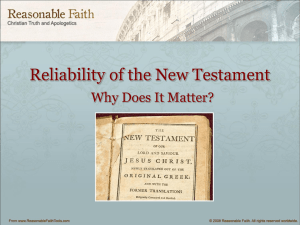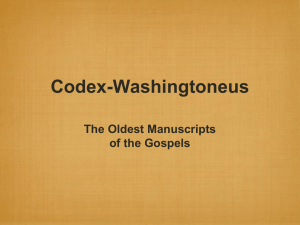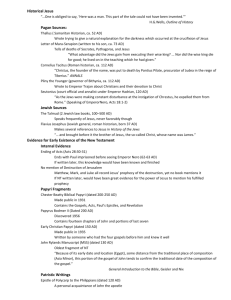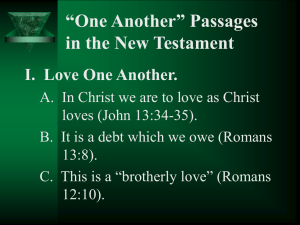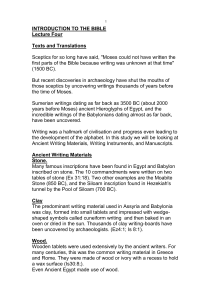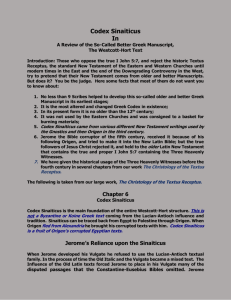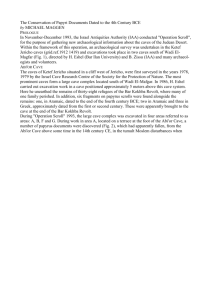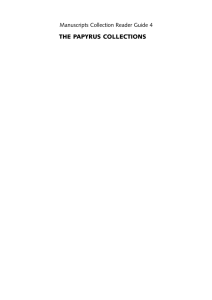NT Ancient Manuscripts
advertisement
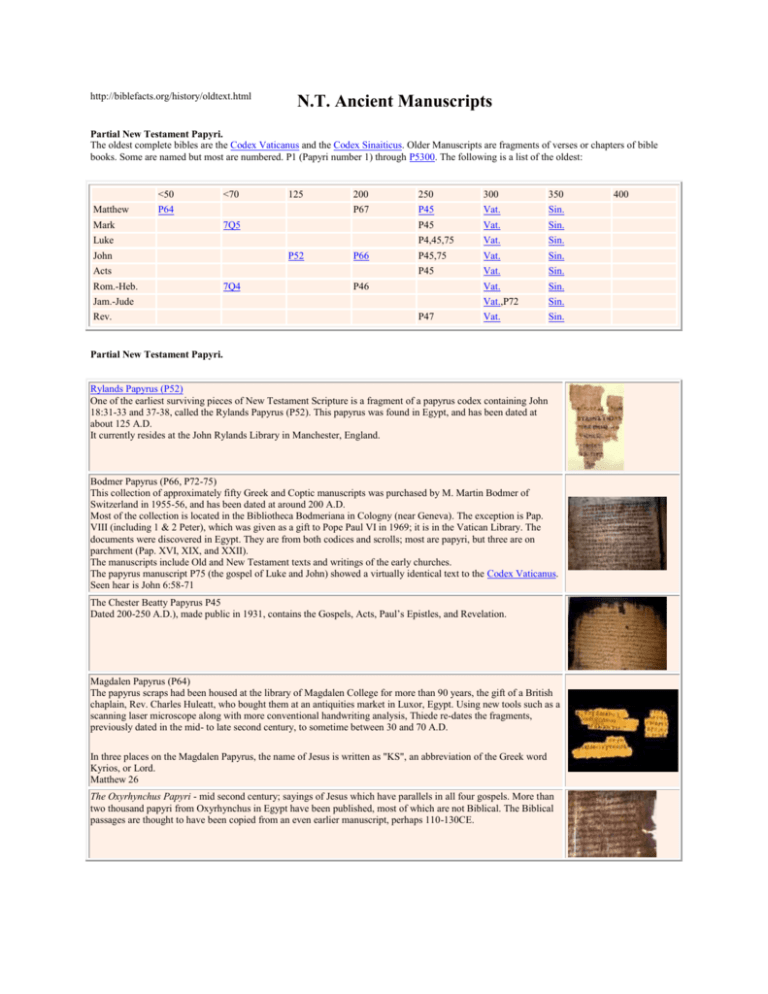
http://biblefacts.org/history/oldtext.html N.T. Ancient Manuscripts Partial New Testament Papyri. The oldest complete bibles are the Codex Vaticanus and the Codex Sinaiticus. Older Manuscripts are fragments of verses or chapters of bible books. Some are named but most are numbered. P1 (Papyri number 1) through P5300. The following is a list of the oldest: <50 Matthew <70 125 P64 Mark 200 250 300 350 P67 P45 Vat. Sin. P45 Vat. Sin. P4,45,75 Vat. Sin. P45,75 Vat. Sin. P45 Vat. Sin. Vat. Sin. Vat.,P72 Sin. Vat. Sin. 7Q5 Luke John P52 P66 Acts Rom.-Heb. 7Q4 P46 Jam.-Jude Rev. P47 Partial New Testament Papyri. Rylands Papyrus (P52) One of the earliest surviving pieces of New Testament Scripture is a fragment of a papyrus codex containing John 18:31-33 and 37-38, called the Rylands Papyrus (P52). This papyrus was found in Egypt, and has been dated at about 125 A.D. It currently resides at the John Rylands Library in Manchester, England. Bodmer Papyrus (P66, P72-75) This collection of approximately fifty Greek and Coptic manuscripts was purchased by M. Martin Bodmer of Switzerland in 1955-56, and has been dated at around 200 A.D. Most of the collection is located in the Bibliotheca Bodmeriana in Cologny (near Geneva). The exception is Pap. VIII (including 1 & 2 Peter), which was given as a gift to Pope Paul VI in 1969; it is in the Vatican Library. The documents were discovered in Egypt. They are from both codices and scrolls; most are papyri, but three are on parchment (Pap. XVI, XIX, and XXII). The manuscripts include Old and New Testament texts and writings of the early churches. The papyrus manuscript P75 (the gospel of Luke and John) showed a virtually identical text to the Codex Vaticanus. Seen hear is John 6:58-71 The Chester Beatty Papyrus P45 Dated 200-250 A.D.), made public in 1931, contains the Gospels, Acts, Paul’s Epistles, and Revelation. Magdalen Papyrus (P64) The papyrus scraps had been housed at the library of Magdalen College for more than 90 years, the gift of a British chaplain, Rev. Charles Huleatt, who bought them at an antiquities market in Luxor, Egypt. Using new tools such as a scanning laser microscope along with more conventional handwriting analysis, Thiede re-dates the fragments, previously dated in the mid- to late second century, to sometime between 30 and 70 A.D. In three places on the Magdalen Papyrus, the name of Jesus is written as "KS", an abbreviation of the Greek word Kyrios, or Lord. Matthew 26 The Oxyrhynchus Papyri - mid second century; sayings of Jesus which have parallels in all four gospels. More than two thousand papyri from Oxyrhynchus in Egypt have been published, most of which are not Biblical. The Biblical passages are thought to have been copied from an even earlier manuscript, perhaps 110-130CE. 400 Qumran cave 7 7q4 1,2 is 1 Timothy 3:16-4:3 7q8 is James 1:23-24 7q6 1,2 is Mark 4:8 and acts 27:38 Qumran cave 7 7q5 is Mark 6:52-53 The Oxyrhynchus Papyri - mid second century; sayings of Jesus which have parallels in all four gospels. More than two thousand papyri from Oxyrhynchus in Egypt have been published, most of which are not Biblical. The Biblical passages are thought to have been copied from an even earlier manuscript, perhaps 110-130CE. P67 - in Barcelona; c. 200CE; contains (Mtt 3:9, 3:15, 15:20-22, 15:25-28). P1 - at the university of Pennsylvania in Philadelphia; third century; contains (Matthew 1:1-9, 1:12-20, 1;23). P4 - in the Bibliothèque Nationale in Paris; third century; extensive sections of the gospel of Luke. P37 - in the University of Michigan Library at Ann Arbor; third or fourth century; 33 verses from Matthew chapter 26. The two oldest Complete New Testament Manuscripts Codex Sinaiticus Dates from the mid fourth century and originally included both Old and New Testaments plus the Epistle of Barnabas and the Shepherd of Hermas, all in Greek. Sin. was found in a monastery library on the slopes of Mount Sinai in 1859 and brought to St. Petersburg. In 1933 it was sold to the British Museum in London where it currently resides. Codex Vaticanus Fourth century Greek codex of the Old and the New Testaments. The codex was brought to the Vatican from Constantinople as a gift to the pope in the fourteenth century. The Old Testament lacks Gen.1-46:28; portions of II Kings 2; and Psalms 105-137. The New Testament is missing Heb. 9:14; I and II Tim.; Titus and Revelation. It was not available to open scholarship until 1889. The original is still in the Vatican. Neither Sinaiticus or Vaticanus contain the last twelve verses of Mark (Mark 16:9-20). However, the verses are included in some earlier fragments, and in the writings of Church fathers, even ones cited by scholars as second century. These are the only two Greek manuscripts (Sinaiticus and Vaticanus), out of a total of 620 which contain the Gospel of Mark, that omit the verses. There are over 5,300 known ancient Greek manuscript copies (MSS) and fragments of the New Testament in Greek that have survived until today. Counting an additional 10,000 Latin Vulgate and over 9,300 other early manuscript versions in Syriac, Coptic, Armenian, Gothic, and Ethiopic, totaling over 24,000 surviving manuscripts of the New Testament. Small changes and variations in manuscripts affect none of the central Christian doctrines, nor do they change the message. Tertullian stated that by 150 A.D., the Church in Rome had compiled a list of the New Testament books matching our list of today. We have 32,000 quotes from before 325 AD, from Irenaeus (182-188 AD), Justin Martyr (before 150 AD), Polycarp (107 AD), Ignatius (100), Clement (96 AD) and many other second and third century fathers. All but eleven verses of the New Testament could be reconstructed through their writings alone. The Muratonian Canon Fragment dating from 170-210 AD lists the same New Testament that we have.

